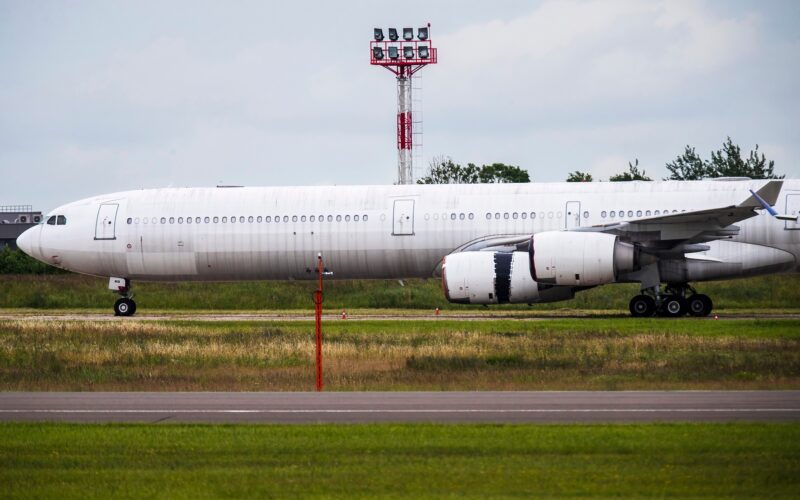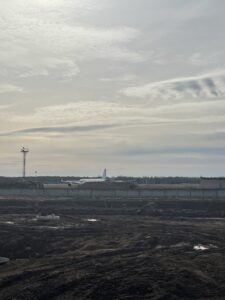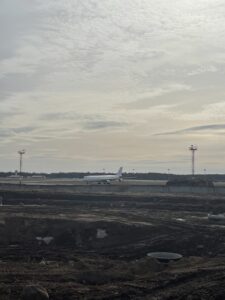For years, Afghanistan has been ravaged by conflict, as external forces have trod the soil of the country, rightfully nicknamed The Graveyard of Empires. In the past few years, control of the country was taken over by the Taliban, a militant movement that has been active in Afghanistan since the 1990s. The conflict within Afghanistan took a turn for the worse in April 2021, when the sitting United States President Joe Biden announced the withdrawal of US troops, just as the Taliban was on the offensive throughout the country.
By August 2021, the militant group seized control and the then-President of Afghanistan, Ashraf Ghani, fled the country. Amidst the chaos at airports, where people attempted their best to find a lifeline and evacuate to a safer location, an Airbus A340-300, registered as YA-WTA and assigned to the Afghani airline Kam Air, flew to Šiauliai, Lithuania, namely Šiauliai International Airport (SQQ) in July 2021. The aircraft appeared on the radar on July 26, 2021, its only flight leg that day, per ADS-B Exchange data. RadarBox records show the aircraft appearing on the radar in southern Uzbekistan, just north of the Afghani border.
The A340-300’s appearance on the ADS-B Exchange radar that day was brief, lasting a little over five minutes between 11:43 and 11:48 PM (UTC +0). Then, at 12:14 AM (UTC +0) on July 27, 2021, the four-engine jet was once again seen on the ADS-B Exchange, flying just north of Voronezh, Russia. An hour and a half later, it landed at its destination, SQQ, where it has been ever since.
SQQ has been one of the two bases of the North Atlantic Treaty Organization (NATO) Baltic Air Policing mission since it was established in 2004. From there, several NATO countries’ fighter jets have rotated to protect the airspace across the three Baltic states, namely Estonia, Latvia, and Lithuania. Overall, according to ch-aviation.com data, there are seven aircraft stored at SQQ: two belong to Lithuania-based GetJet Airlines, while one A330-300, registered as 9H-AHQ, belongs to Airhub Airlines. The A330 was recently spotted doing flight tests, as flightradar24.com records show the aircraft departing and arriving at SQQ following a 28-minute flight on April 6, 2023.
The remaining aircraft, barring the Kam Air A340-300, are all Airbus A340s, registered as C5-MIA, C5-MIB, and C5-MIC. The trio belongs to Macka Invest, per ch-aviation.com, possibly a Belgium-based landscape company of the same name that had €30,278 ($32.453) of equity as of the end of 2021, according to the financial report it filed to the National Bank of Belgium. All three of Macka Invest’s A340s arrived at the airport they are currently stored at back in May 2022. The C5 prefix to the aircraft’s registration is assigned to Gambia, a country located in Western Africa.
Meanwhile, an entirely different company called Macka Invest was dissolved in March 2021, according to a document published by the Republic of Seychelles.
However, ch-aviation.com data shows that the three A340s were registered with the Gambian authorities in May 2022. According to the United Kingdom Civil Aviation Administration (CAA), C5-MIC, previous registration G-ECLA, was deregistered in October 2021 and was due to be registered in the United States (US). Meanwhile, C5-MIA had a reserved registration in the US as N474JS. However, this was canceled, and the aircraft was exported to Indonesia on March 10, 2020. Planespotters.net data shows that the aircraft ended up in Malaysia, where C5-MIB and C5-MIC were also stored before being ferried to SQQ.
AeroTime has been able to obtain visual confirmation of the presence of the quartet of Airbus A340s that are stored at SQQ.
But this begs the question: what are these aircraft, including a Kam Air Airbus A340-300, doing in a NATO Air Policing Base?
History of Siauliai International Airport (SQQ)
Throughout its history, the airport has always served as a military base. Tracing its roots back to 1931, the locale, also known as Zoknių Karo aviacijos bazė (Zokniai military aviation base), together with the Lithuanian state, changed hands throughout the 20th century.
With SQQ having the longest runway in the Baltic States at 3500 meters (2.1 miles), the strategic importance of the location has remained since Lithuania regained its independence. Once the country joined NATO in 2004, the first two F-16s of the Belgian Air Component landed at SQQ, officially beginning the Baltic Air Policing Mission on March 29, 2004.
In November 2003, the Šiauliai city municipality registered a publicly-owned company called Šiaulių oro uostas. While the company, whose name literally translates as ‘Šiauliai airport’, was presumably established to provide services to the NATO Baltic Air Policing mission, the municipality began exploring options on how to expand and increase the revenue of the airport. In November 2011, it embarked upon a two-year project to study the business opportunities of SQQ. “Despite the attractive technical characteristics, the geographical location of the airport, and low service costs, the cargo volumes at the airport remain very low,” the project’s description read. It cost the European Union (EU) up to LTL372,126 ($117,581), while the municipality pitched in LTL65,669 ($20,750) for a total project cost of LTL437,795 ($138,327).
The goal of the project was to use the business opportunity study to prepare a master plan for the airport that would remain valid “even until 2027”.
In 2018, those plans began to move forward. The local municipality signed an agreement with a company – whose legal name was Termicom, which it changed to Aviatic MRO in March 2019 – to develop the airport, with the company pledging an initial investment of up to €10 million ($10.9 million). To help the development of the airport, the municipality itself initially pledged up to €5.5 million ($6 million) to renovate taxiways at SQQ, while also expanding the engineering infrastructure at the airport.
Developing an MRO business at SQQ
When the agreement between the Šiauliai city municipality and Termicom was signed in May 2018, the company committed to opening a Maintenance, Repair, and Overhaul (MRO) facility by 2020 and to operate it for at least five years.
For the municipality, the reason as to why it would need to attract an investor to SQQ was clear: it needed to turn around the fortunes of the company that owns the airport. Between 2016 and 2019, the airport was loss-making, but the managing company finally earned a net profit of €46,000 ($50,190) and €50,000 ($54,555) in 2020 and 2021, respectively. While the COVID-19 pandemic largely ravaged the air travel industry, aircraft parking fees helped the airport to recover, according to the municipality’s news about the airport’s 2021 financial results. However, although Aviatic MRO initially pledged to build the MRO hangar by 2020, the municipality’s news article reads that the construction work for it is still “ongoing”.
By then, Aviatic MRO had invested around €2 million ($2.1 million). The Chief Executive Officer (CEO) of the company, Povilas Padaiga, mentioned that the MRO organization’s “hangar should begin working at the beginning of summer [2021]”. On its own website, Aviatic MRO’s February 2020 announcement about its newly established business at SQQ read that it “will deliver maintenance solutions for the Airbus A320 Family, Boeing 737 classic and NG series, including D-checks, management of assets, the provision of parking spaces and part-out or scrap services”.
“The growing and aging aircraft fleet in Europe, as well as the increasing need for air travel is resulting in a higher demand for MRO services,” added the then-CEO of Aviatic MRO, Artūras Liudkevičius. According to his LinkedIn profile, Liudkevičius was the chief executive of the company between October 2019 and June 2020, replacing Povilas Padaiga, who was at the helm of the company between January 2016 and October 2019. Padaiga later replaced Liudkevičius, becoming the CEO once again after the latter was no longer at Aviatic MRO.
Security interests
However, according to the Lithuanian news site Delfi, the commission for the protection of objects important to ensuring national security, a commission established by the Government of the Republic of Lithuania, initially denied the then-Termicom from investing in the facilities at SQQ.
In an article by Baltic News Service (BNS), a spokesman of the then-Prime Minister of Lithuania stated that the company that would be known as Aviatic MRO had received approval from the commission on their second attempt, as at first, “some facts were conflicting with the interests of the state and the commission provided a negative conclusion [to the decision to allow Termicom to invest into SQQ]”. Delfi pointed out that Termicom had changed its shareholder structure, as Dmitrij Celiadin, one of the former shareholders of Termicom, handed over his shares to an Estonia-registered company Completec. The Estonian company registry currently shows Celiadin as its only representative, and according to State Enterprise Centre of Registers of Lithuania, the only shareholder of Aviatic MRO is Completec, with Padaiga listed as the Director of the company. Per rekvizitai.lt data, the company’s management structure changed in May 2017.
In addition, Completec is a shareholder of GetJet Airlines, a Lithuanian Aircraft, Crew, Maintenance, and Insurance (ACMI) provider, also associated with Airhub Airlines, a Maltese ACMI provider. Alexander Celiadin, the brother of Dmitrij Celiadin, is listed as the Chairman of both ACMI operators.

Perhaps the reason why the Kam Air Airbus A340-300 has ended up at the Lithuanian airport is that, when Afghanistan’s situation was changing, the airline or the new owner of the aircraft was looking for a place to store the wide-body jet. According to planespotters.net data, the aircraft was not taken up (NTU) by Airhub Airlines, with its final registration being unclear. Still, the Maltese prefix of 9H was assigned to the ex-Kam Air A340.
In an emailed statement, a representative of SQQ told AeroTime that “permission to land at SQQ is provided by the military base and before the landing approval military personnel check the registration and the owner of AC”.
A document by Transport Malta (TM) shows that there are 14 Airbus A340s registered in the country, 10 of which are A340-300s. Two of them are owned by Airbus Financial Services, one is owned by Air X Charter, and five are under the ownership of Hi Fly Malta, the Portuguese ACMI operator’s Maltese subsidiary. Meanwhile, 9H-TQY is shown as owned by Aquilam, while ch-aviation.com data shows the aircraft being associated with Hi Fly Malta as well.
Between 2014 and 2016, Termicom’s legal name was Elteza, sharing the same name as a Russian-based company that builds various products for railway transport. Currently, Russian Railways is listed as the majority shareholder of the Russian-based Elteza.
Meanwhile, Completec has two listed areas of activity, namely wholesale of electrical material and their requisites and electrical machines, including cables, and rental and leasing of cars and light motor vehicles, according to the Estonian company registry. An analysis of the company’s annual accounts showed that although Completec earned €0 revenue from Russia during 2012, the figure grew to €22,148 ($24,191) in 2013, then €33,399 ($36,416) in 2014, before decreasing to €20,618 ($22,521) in 2015, and going back to zero once again in 2016, the same year that the Lithuania-based Elteza was once again renamed to Termicom.
Aviatic MRO has declined to comment on this story.




